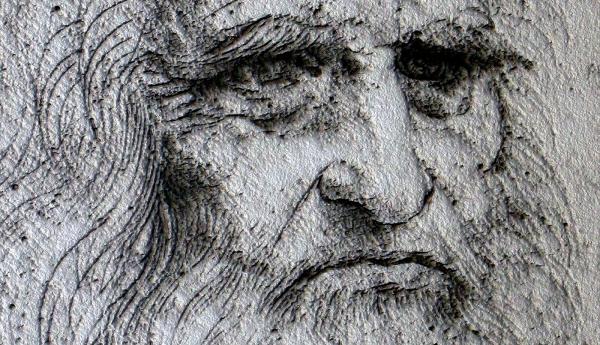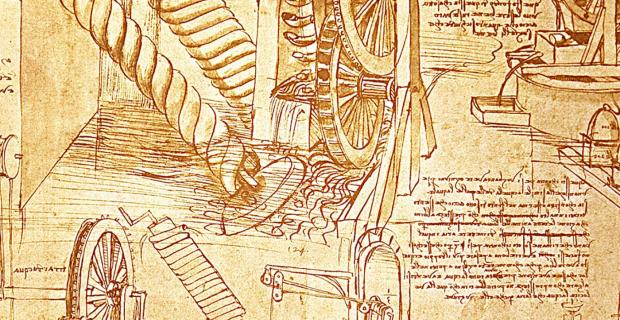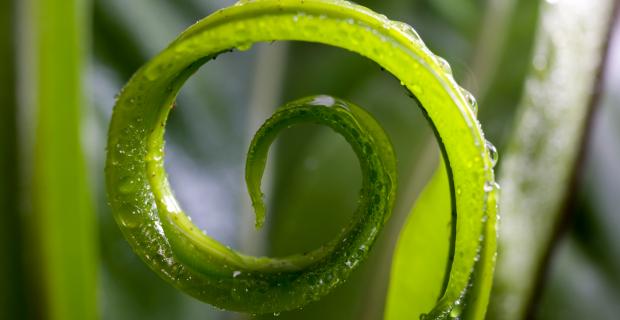New Lessons from Leonardo

This essay is adapted from a talk in which Fritjof Capra discusses some of the findings described in his latest book, Learning from Leonardo: Decoding the Notebooks of a Genius (2013: Berrett-Koehler Publishers).
Leonardo da Vinci, the great genius of the Renaissance, developed and practiced a unique synthesis of art, science, and technology, which is not only extremely interesting in its conception but also very relevant to our time.
As we recognize that our sciences and technologies have become increasingly narrow in their focus, unable to understand our multi-faceted problems from an interdisciplinary perspective, we urgently need a science and technology that honor and respect the unity of all life, recognize the fundamental interdependence of all natural phenomena, and reconnect us with the living Earth. What we need today is exactly the kind of synthesis Leonardo outlined 500 years ago.
A science of living forms
At the core of Leonardo's synthesis lies his life-long quest for understanding the nature of the living forms of nature. He asserts repeatedly that painting involves the study of natural forms, of qualities, and he emphasizes the intimate connection between the artistic representation of those forms and the intellectual understanding of their intrinsic nature and underlying principles. In order to paint nature's living forms, Leonardo felt that he needed a scientific understanding of their intrinsic nature and underlying principles, and in order to analyze the forms of nature, he needed the artistic ability to draw them. His science cannot be understood without his art, nor his art without the science.
The quest for the secret of life
I have been fascinated by the genius of Leonardo Lea Vinci and have spent the last ten years studying his scientific writings in facsimile editions of his famous notebooks. In my new book, I present an in-depth discussion of the main branches of Leonardo's scientific work — his fluid dynamics, geology, botany, mechanics, science of flight, and anatomy. Most of his astonishing discoveries and achievements in these fields are virtually unknown to the general public.
What emerged from my explorations of all the branches of Leonardo's science was the realization that, at the most fundamental level, Leonardo always sought to understand the nature of life. My main thesis is that the science of Leonardo da Vinci is a science of living forms, radically different from the mechanistic science of Galileo, Descartes, and Newton that emerged 200 years later.
This has often escaped earlier commentators, because until recently the nature of life was defined by biologists only in terms of cells and molecules, to which Leonardo, living two centuries before the invention of the microscope, had no access. But today, a new systemic understanding of life is emerging at the forefront of science — an understanding in terms of metabolic processes and their patterns of organization; and those are precisely the phenomena which Leonardo explored throughout his life, both in the macrocosm of the Earth and in the microcosm of the human body.
In the macrocosm, the main themes of Leonardo's science were the movements of water, the geological forms and transformations of the Earth, and the botanical diversity and growth patterns of plants. In the microcosm, his main focus was on the human body — its beauty and proportions, the mechanics of its movements, and the understanding of the nature and origin of life. Let me give you a very brief summary of his achievements in these diverse scientific fields.
The movements of water
Leonardo was fascinated by water in all its manifestations. He recognized its fundamental role as life's medium and vital fluid, as the matrix of all organic forms: "It is the expansion and humor of all living bodies," he wrote. "Without it nothing retains its original form." This view of the essential role of water in biological life is fully borne out by modern science. Today we know not only that all living organisms need water for transporting nutrients to their tissues, but also that life on Earth began in water, and that for billions of years, all the cells that compose living organisms have continued to flourish and evolve in watery environments. So, Leonardo was completely correct in viewing water as the carrier and matrix of life.
Throughout his life, Leonardo studied its movements and flows, drew and analyzed its waves and vortices. He experimented not only with water but also investigated the flows of blood, wine, oil, and even those of sand and grains. He was the first to formulate the basic principles of flow, and he recognized that they are the same for all fluids. These observations establish Leonardo da Vinci as a pioneer in the discipline known today as fluid dynamics.
Leonardo's manuscripts are full of exquisite drawings of spiraling vortices and other patterns of turbulence in water and air, which until now have never been analyzed in detail, because the physics of turbulent flows is notoriously difficult. In this book, I present an in-depth analysis of Leonardo's drawings of turbulent flows, based on extensive discussions with Ugo Piomelli, professor of fluid dynamics at Queen's University in Canada, who very generously helped me to analyze all of Leonardo's drawings and descriptions of turbulent flows.
The living Earth
Leonardo saw water as the chief agent in the formation of the Earth's surface. This awareness of the continual interaction of water and rocks impelled him to undertake extensive studies in geology, which informed the fantastic rock formations that appear so often in the shadowy backgrounds of his paintings. His geological observations are stunning not only by their great accuracy, but also because they led him to formulate general principles that were rediscovered only centuries later and are still used by geologists today.
Leonardo was the first to postulate that the forms of the Earth are the result of slow processes taking place over long epochs of what we now call geological time.
With this view, Leonardo was centuries ahead of his time. Geologists became aware of the great duration of geological time only in the early 19th century with the work of Charles Lyell, who is often considered the father of modern geology.
Leonardo was also the first to identify folds of rock strata. His descriptions of how rocks are formed over enormously long periods of time in layers of sedimentation and are subsequently shaped and folded by powerful geological forces come close to an evolutionary perspective. He arrived at this perspective 300 years before Charles Darwin, who also found inspiration for evolutionary thought in geology.
The growth of plants
Leonardo's notebooks contain numerous drawings of trees and flowering plants, many of them masterpieces of detailed botanical imagery. These drawings were at first made as studies for paintings, but soon turned into genuine scientific inquiries about the patterns of metabolism and growth that underlie all botanical forms. Leonardo paid special attention to the nourishment of plants by sunlight and water, and to the transport of the sap through the plants' tissues.
He correctly distinguished between the dead outer layer of a tree's bark and the living inner bark, known to botanists as the phloem, which he called very aptly "the shirt that lies between the bark and the wood." He was also the first to recognize that the age of a tree corresponds to the number of rings in the cross-section of its trunk, and — even more remarkably — that the width of a growth ring is an indication of the climate during the corresponding year. As in so many other fields, Leonardo carried his botanical thinking far beyond that of his peers, establishing himself as the first great theorist in botany.
The human body in motion
Whenever Leonardo explored the forms of nature in the macrocosm, he also looked for similarities of patterns and processes in the human body. In order to study the body's organic forms, he dissected numerous corpses of humans and animals, and examined their bones, joints, muscles, and nerves, drawing them with an accuracy and clarity never seen before. Leonardo demonstrated in countless elaborate and stunning drawings how nerves, muscles, tendons and bones work together to move the body.
Unlike Descartes, Leonardo never thought of the body as a machine, even though he was a brilliant engineer who designed countless machines and mechanical devices. He clearly recognized that the anatomies of animals and humans involve mechanical functions. "Nature cannot give movement to animals without mechanical instruments," he explained, but that did not imply for him that living organisms were machines. It only implied that, in order to understand the movements of the animal body, he needed to explore the principles of mechanics. Indeed, he saw this as the most "noble" role of this branch of science.
Elements of mechanics
To understand in detail how nature's "mechanical instruments" work together to move the body, Leonardo immersed himself in prolonged studies of problems involving weights, forces, and movements — the branches of mechanics known today as statics, dynamics, and kinematics. While he studied the elementary principles of mechanics in relation to the movements of the human body, he also applied them to the design of numerous new machines, and as his fascination with the science of mechanics grew, he explored ever more complex topics, anticipating abstract principles that were centuries ahead of his time.
These include his understanding of the relativity of motion, his discovery of the principle now known as Newton's third law of motion, his intuitive grasp of the conservation of energy, and — perhaps most remarkably — his anticipation of the law of energy dissipation, the second law of thermodynamics. Although there are many books on Leonardo's mechanical engineering, there is as yet none on his theoretical mechanics. In the longest chapter of this book, I provide an in-depth analysis of this important branch of Leonardo's science.
The science of flight
From the texts that accompany Leonardo's anatomical drawings we know that he considered the human body as an animal body, as biologists do today; and thus it is not surprising that he compared human movements with the movements of various animals. What fascinated him more than any other animal movement was the flight of birds. It was the inspiration for one of the great passions in his life — the dream of flying.
The dream of flying like a bird is as old as humanity itself. But nobody pursued it with more intensity, perseverance, and commitment to meticulous research than Leonardo da Vinci. His science of flight involved numerous disciplines — from aerodynamics to human anatomy, the anatomy of birds, and mechanical engineering.
In my chapter on Leonardo's science of flight, I analyze his drawings and writings on this subject in some detail, and I come to the conclusion that he had a clear understanding of the origin of aerodynamic lift, that he fully understood the essential features of both soaring and flapping flight, and that he was the first to recognize the principle of the wind tunnel — that a body moving through stationary air is equivalent to air flowing over a stationary body. This establishes Leonardo da Vinci as one of the great pioneers of aerodynamics.
In his numerous designs of flying machines, Leonardo attempted to imitate the complex flapping and gliding movements of birds. Many of these designs were based on sound aerodynamic principles, and it was only the weight of the materials available in the Renaissance that prevented him from building viable models.
The mystery of life
As I have mentioned, the grand unifying theme of Leonardo's explorations of the macro- and microcosm was his persistent quest to understand the nature of life. This quest reached its climax in the anatomical studies he carried out in Milan and Rome when he was over sixty, especially in his investigations of the heart — the bodily organ that has served as the foremost symbol of human existence and emotional life throughout the ages. He not only understood and pictured the heart in ways no one had before him; he also observed subtleties in its actions that would elude medical researchers for centuries.
During the last decade of his life, Leonardo became intensely interested in another aspect of the mystery of life — its origin in the processes of reproduction and embryonic development. In his embryological studies, he described the life processes of the fetus in the womb, including its nourishment through the umbilical cord, in astonishing detail. Leonardo's embryological drawings are graceful and touching revelations of the mysteries surrounding the origins of life.
Leonardo knew very well that, ultimately, the nature and origin of life would remain a mystery, no matter how brilliant his scientific mind. "Nature is full of infinite causes that have never occurred in experience," he declared in his late forties, and as he got older, his sense of mystery deepened. Nearly all the figures in his last paintings have that smile that expresses the ineffable, often combined with a pointing finger. "Mystery to Leonardo," wrote the famous art historian Kenneth Clark, "was a shadow, a smile, and a finger pointing into darkness."




